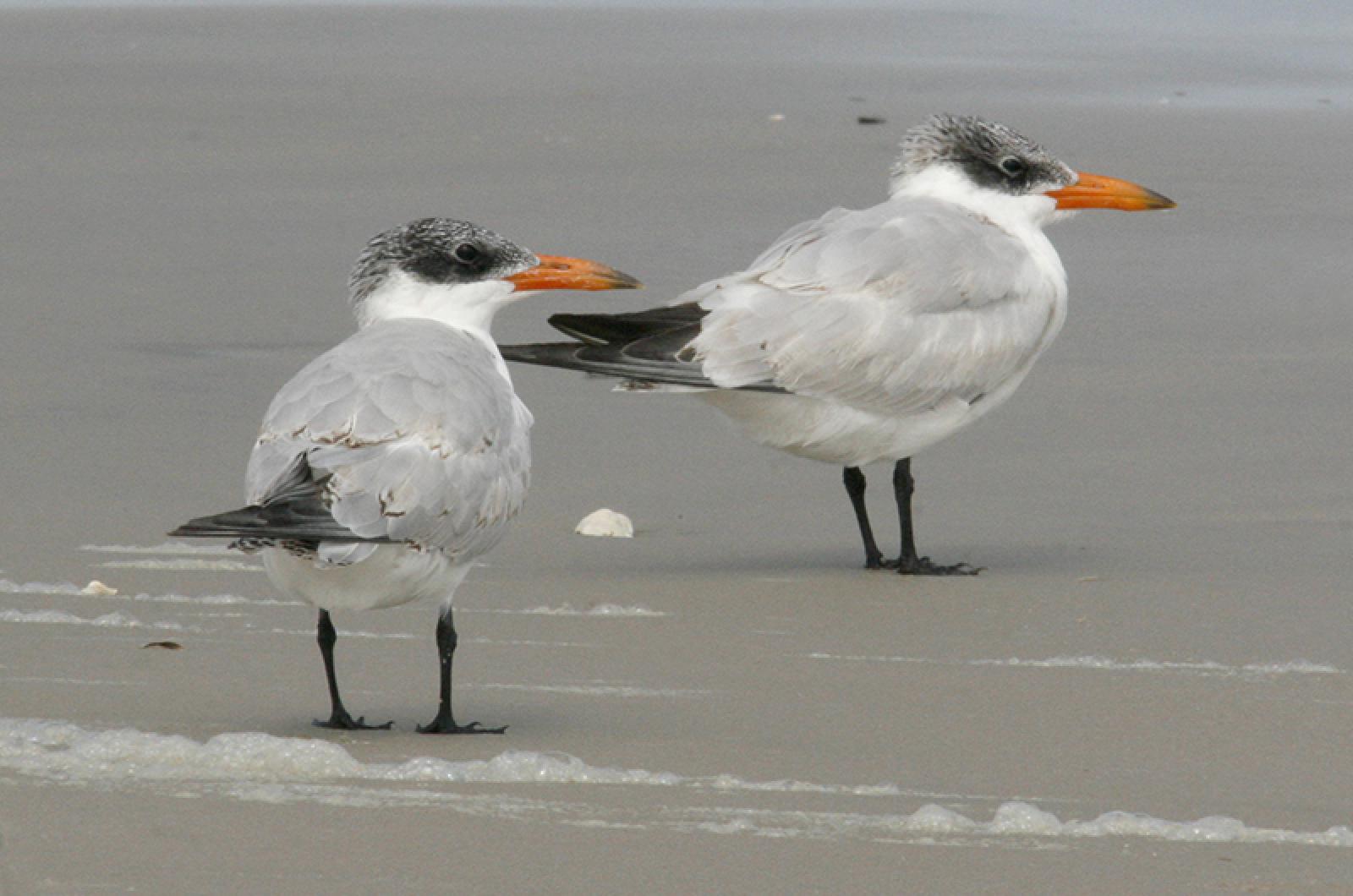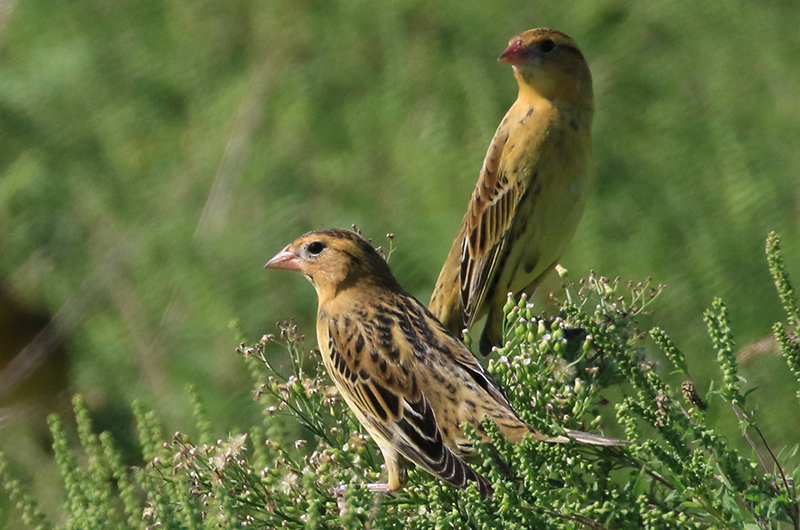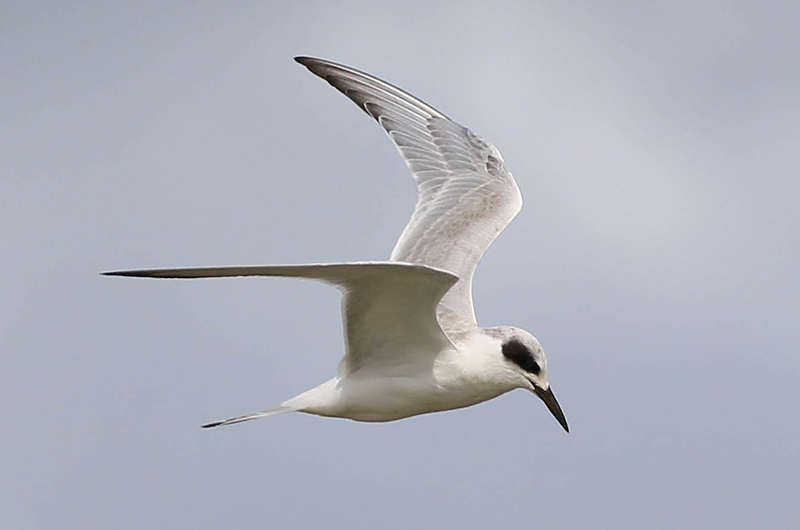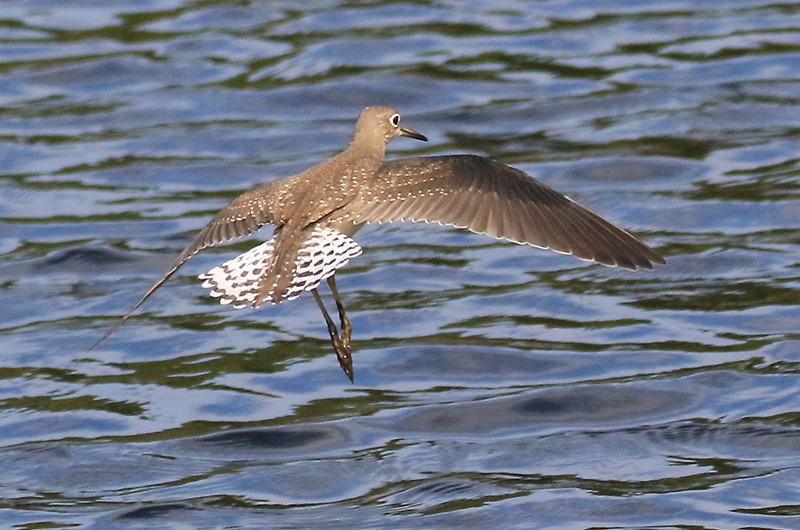Although Caspian terns often show up in late September and October, their southward migration from Canada to Mexico along the Atlantic Coast is now peaking. One of these large red-billed terns was spotted on Norton Point on Aug. 27 by Pete Gilmore and Francesca Zeta. Francesca also spotted four whimbrel and nine red knots that day. Three red knots were seen by John Rogers and David Padulo on Norton Point on Aug. 30; David also saw one on Little Beach the next day. Warren Woessner spotted “all the usual shorebirds” plus a whimbrel and a black tern there on Aug. 26.
Another regular fall sighting is that of an American golden plover. They are rather similar to the more common black-bellied plovers, but can be distinguished with a bit of practice. Matt Pelikan spotted one in some of the short grass at the Farm Institute on Aug. 30.
A western willet — a larger and grayer version of our more common eastern willet — was spotted at Little Beach by Pete Gilmore on Aug. 31.
Solitary sandpipers, as their name suggests, are usually by themselves. Ian Fitzgerald saw one at the Gay Head moraine on Aug. 29, and Susan McCoy spotted one at Blackwater Pond the next day.
From Menemsha Pond, Bob Shriber reports a Forster’s tern and a snowy egret on Aug. 27. And two yellow-crowned night-herons showed up at Felix Neck on Aug. 26, as reported by Christopher Suozzo and Ian Fitzgerald.
On the large predator front, the adult bald eagle reported last week is still around, spotted on Aug. 26 by Alysa Emden and Nancy Weaver. In osprey news, Rob Bierregaard reports that females have already left for points south while males and youngsters typically leave in the first half of September. So the ospreys seen this past week by Katherine May-Waite, Nancy Slate, Jeff Bernier, Jenifer Strachan and myself are likely males or young-of-the-year.
On Aug. 27, green herons were spotted by Katherine May-Waite at the Head of the Lagoon and by Hans Goeckel at Slough Cove. And Pete Gilmore spotted a wood duck at Sepiessa on Aug. 26.
Common nighthawk migration is peaking now, but we do not see them very frequently. They are strong fliers and can blast past before they are recognized. This week there were two nighthawk sightings — Enrico Leonardi spotted one over the Menemsha Inn on Aug. 26 while Jeff Peters and John Rogers spotted one over Mink Meadows on Aug. 29. Mr. Leonardi also spotted a rose-breasted grosbeak there.
Another infrequently observed species is the diminutive blue-gray gnatcatcher, which is only slightly larger than a hummingbird. Most of its length is its long tail. One was spotted by Bob Shriber in Aquinnah on Aug. 29, where he also saw an ovenbird and a common yellowthroat.
Jeff Peters spotted two bobolinks on Aug. 29 at the Farm Institute and Matt Pelikan had a lot of bobolinks flying overhead there the next day. Bob Shriber also spotted them in Aquinnah on Aug. 31. Back at the Farm Institute on Aug. 29, Lanny McDowell and Pete Gilmore spotted a northern waterthrush flying by. This is not the typical place for this generally woodlands-loving species. A merlin flew by a short while later. Bob Shriber spotted another merlin in Aquinnah on Aug. 31.
The abundance of orioles continues this week. Kathleen Kinsman counted seven orioles at her feeders on Aug. 28, while Skip MacElhannon counted six. “The most we have seen all summer,” he reported.
Sharon Simonin had an oriole visit her yard for the first time on Aug. 26, and Sheilah Hughes also has visiting orioles.
Also fairly abundant are red-breasted nuthatches. David Padulo observed some at both Sheriff’s Meadow sanctuary and in Edgartown Estates on Aug. 31, while Bob Shriber observed 10 of them in Aquinnah that same day.
Ruby-throated hummingbirds will be migrating through in peak numbers well into the middle of September, but some will linger longer so keep your sugar-water feeders out. Multiple observers have reported them this week, including Sharon Simonin, Kevin Searle, Vicki Bologna, Ellen Obrien, Anne and Danny Whiting, Holly Mercier, Julie McNary, Bonnie Parent, Laura Hilliard, Lanny McDowell, Luanne Johnson, Alex Lin-Moore, Cynthia Bloomquist, Calvin Keating, Walt Looney, Bob Shriber and Christopher Suozzo.
It is also the beginning of the season for swarms of swallows, specifically tree swallows. Tom Hodgson reports the first swarm of tree swallows on Aug. 29. There will be many more swarms of them as they feast on insects, bayberries and juniper berries. And though they can be found over any part of the Island, they are most frequent along our Chappaquiddick and South Shore beaches. It is an amazing feeling to be amidst one of these swarms.
Robert Culbert is an ecological consultant with Nature Watch LLC living in Vineyard Haven.










Comments
Comment policy »